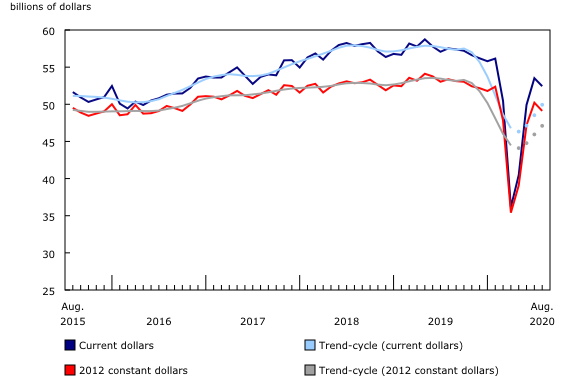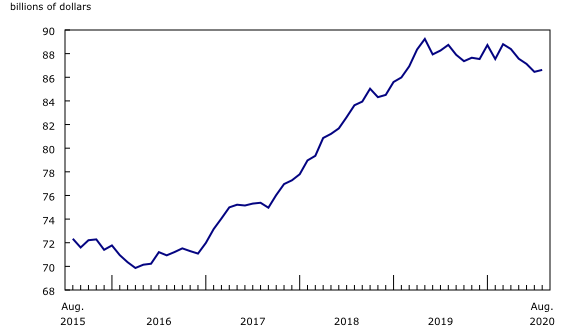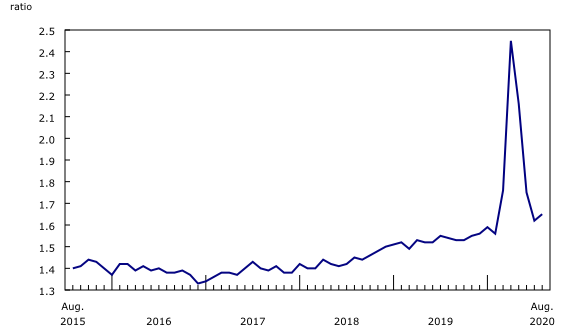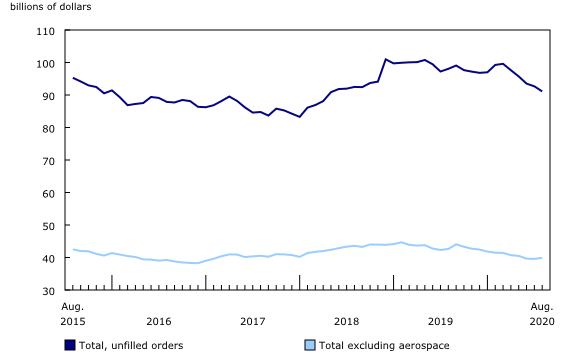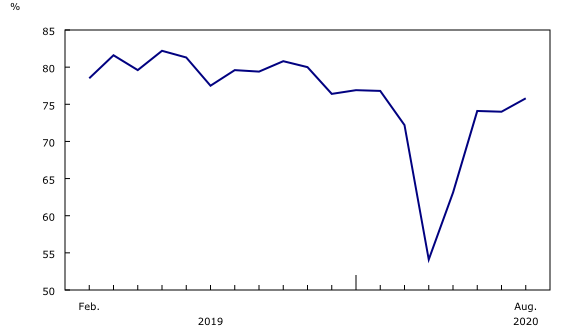Monthly Survey of Manufacturing, August 2020
Archived Content
Information identified as archived is provided for reference, research or recordkeeping purposes. It is not subject to the Government of Canada Web Standards and has not been altered or updated since it was archived. Please "contact us" to request a format other than those available.
Released: 2020-10-16
Manufacturing sales fell 2.0% to $52.4 billion in August, following three consecutive months of strong increases. The largest declines were in the transportation equipment and plastics and rubber industries. Excluding transportation equipment, manufacturing sales rose 1.1%. Total manufacturing sales in August were 6.6% below February's pre-pandemic levels.
Manufacturing sales in constant dollar fell 2.2%, indicating a smaller volume of products was sold in August.
Transportation equipment leads the decline
Sales in the transportation equipment industry fell 13.7% to $9.6 billion in August, following three consecutive months of large gains. The decline was mostly attributable to lower sales of motor vehicle assembly (-12.5%) and motor vehicle parts (-16.8%). Although several car assembly plants shortened or skipped their annual maintenance shutdowns to build up inventories in July, sales in August were weaker coming off a stronger than usual July. According to Canadian international merchandise trade data, Canada exported 6.8% fewer motor vehicles and parts in August.
Following three consecutive monthly increases and record high sales in July, sales of plastic and rubber products decreased 9.6% to $2.6 billion in August. Sales of plastic and rubber products in constant dollars fell 9.6%.
Sales of wood products were up for the fourth consecutive month, rising 12.3% to $3.0 billion in August on higher prices and volumes. Year over year, sales of wood products grew 26.0%. According to the Building Permits Survey, the total value of residential sector permits in Ontario and Quebec rose in August. Higher exports of lumber (+16.5%), particularly to the United States, also contributed to the gain.
Sales in the miscellaneous industry rose for the fourth consecutive month, up 12.0% to a record $1.3 billion in August on higher sales of silver and gold. The capacity utilization rate in the miscellaneous industry stood at 78.0% in August, up from 76.3% in July.
Sales decline in Ontario and rise in British Columbia and Manitoba
Manufacturing sales decreased in four provinces in August, led by Ontario.
Following three consecutive monthly gains, sales in Ontario were down 4.8% to $24.9 billion in August. Sales declined in 9 of 21 industries, led by the motor vehicle (-12.3%), motor vehicle parts (-17.1%) and plastics and rubber products (-14.5%) industries.
Manufacturing sales in British Columbia continued to rebound from the pandemic-related shutdown this spring, rising 5.1% to $4.5 billion in August on higher sales of wood products. Total manufacturing sales in the province were 4.6% higher than February levels.
In Manitoba, sales were up 5.9% to $1.7 billion in August, following a 13.7% gain in July. Sales were up in 16 industries led by the machinery industry.
Montréal leads the sales decline among selected census metropolitan areas
Manufacturing sales on an unadjusted basis were down in 8 of the 12 selected census metropolitan areas in August, led by Montréal. Lower sales of transportation equipment and primary metal contributed the most to the decline in Montréal.
Sales in Winnipeg rose for the fourth consecutive month, up 12.7% in August on higher sales of transportation equipment and clothing.
Uptick in inventory levels
Total manufacturing inventories edged up 0.2% to $86.6 billion in August, following four consecutive monthly declines. Inventories were up in 13 of 21 industries, led by machinery and food manufacturing.
Despite the growth in August, total manufacturing inventories were 1.0% below February's pre-pandemic levels. Total inventories were down $2.1 billion year over year.
Following three consecutive monthly declines, the inventory-to-sales ratio rose from 1.62 in July to 1.65 in August. Just prior to the pandemic in February, the level stood at 1.56. This ratio measures the time, in months, that would be required to exhaust inventories if sales were to remain at their current level.
Unfilled orders decline
Total unfilled orders for the manufacturing sector decreased for the fifth consecutive month, falling 1.7% to $91.1 billion in August—the lowest level since May 2018. The aerospace product and parts industry was primarily responsible for the decline (-3.6%). The appreciation of the Canadian dollar relative to the US dollar in August partially contributed to the drop in unfilled orders.
Unfilled orders also fell in the electrical equipment, appliance and component industry (-10.1%).
Unfilled orders rose 6.0% in non-durable goods industries in August, led by the chemical industry.
Following three consecutive monthly gains, new orders fell 3.4% to $50.9 billion in August, mostly due to lower new orders in the aerospace products and parts industry. The declines in new orders were partially offset by an increase in new orders in the wood product industry.
Capacity utilization rate increases
The capacity utilization rate (not seasonally adjusted) for the total manufacturing sector rose from 74.0% in July to 75.8% in August due to higher manufacturing production. Manufacturing employment also continued its rebound according to the Labour Force Survey, rising 1.8% in August. Despite lower sales of transportation equipment in August, higher production of motor vehicle and parts led to a 4.1 percentage point increase in the capacity utilization rate of the transportation industry.
Sustainable Development Goals
On January 1, 2016, the world officially began implementation of the 2030 Agenda for Sustainable Development—the United Nations' transformative plan of action that addresses urgent global challenges over the next 15 years. The plan is based on 17 specific sustainable development goals.
The Monthly Survey of Manufacturing is an example of how Statistics Canada supports the reporting on the Global Goals for Sustainable Development. This release will be used in helping to measure the following goal:

Note to readers
While the quality of this month's data remains high, response rates from manufacturers have fallen from the usual 95% to a rate of 88% in August. Every effort has been made to supplement this month's data with information from other sources.
Monthly data in this release are seasonally adjusted and are expressed in current dollars unless otherwise specified.
Seasonally adjusted data are data that have been modified to eliminate the effect of seasonal and calendar influences to allow for more meaningful comparisons of economic conditions from period to period. For more information on seasonal adjustment, see Seasonally adjusted data – Frequently asked questions.
Trend-cycle estimates are included in selected charts as a complement to the seasonally adjusted series. These data represent a smoothed version of the seasonally adjusted time series and provide information on longer-term movements including changes in direction underlying the series. For information on trend-cycle data, see Trend-cycle estimates – Frequently asked questions.
Both seasonally adjusted data and trend-cycle estimates are subject to revision as additional observations become available. These revisions could be large and could even lead to a reversal of movement, especially for reference months near the end of the series or during periods of economic disruptions.
Non-durable goods industries include food, beverage and tobacco products, textile mills, textile product mills, clothing, leather and allied products, paper, printing and related support activities, petroleum and coal products, chemicals, and plastics and rubber products.
Durable goods industries include wood products, non-metallic mineral products, primary metals, fabricated metal products, machinery, computer and electronic products, electrical equipment, appliances and components, transportation equipment, furniture and related products, and miscellaneous manufacturing.
Production-based industries
For the aerospace and shipbuilding industries, the value of production is used instead of the value of sales of goods manufactured. The value of production is calculated by adjusting monthly sales of goods manufactured by the monthly change in inventories of goods in process and finished products manufactured. The value of production is used because of the extended period of time that it normally takes to manufacture products in these industries.
Unfilled orders are a stock of orders that will contribute to future sales assuming that the orders are not cancelled.
New orders are those received, whether sold in the current month or not. New orders are measured as the sum of sales for the current month plus the change in unfilled orders from the previous month to the current month.
Manufacturers reporting sales, inventories and unfilled orders in US dollars
Some Canadian manufacturers report sales, inventories and unfilled orders in US dollars. These data are then converted to Canadian dollars as part of the data production cycle.
For sales, based on the assumption that they occur throughout the month, the average monthly exchange rate for the reference month established by the Bank of Canada is used for the conversion. The monthly average exchange rate is available in table 33-10-0163-01. Inventories and unfilled orders are reported at the end of the reference period. For most respondents, the noon spot exchange rate on the last working day of the month is used for the conversion of these variables.
However, some manufacturers choose to report their data as of a day other than the last day of the month. In these instances, the daily average exchange rate on the day selected by the respondent is used. Note that because of exchange rate fluctuations, the daily average exchange rate on the day selected by the respondent can differ from both the exchange rate on the last working day of the month and the monthly average exchange rate. Daily average exchange rate data are available in table 33-10-0036-01.
Revision policy
Each month, the Monthly Survey of Manufacturing releases preliminary data for the reference month and revised data for the three previous months. Revisions are made to reflect new information provided by respondents and updates to administrative data.
Once a year, a revision project is undertaken to revise multiple years of data. Statistics Canada will release revised monthly manufacturing data on November 16, in accordance with standard practices. Sales of goods manufactured, inventories and orders in current dollars will be revised back to January 2013 for unadjusted data and to January 2011 for seasonally adjusted and constant dollar data.
Real-time data tables
Real-time data tables 16-10-0118-01, 16-10-0119-01, 16-10-0014-01 and 16-10-0015-01 will be updated on October 27.
Next release
Data from the Monthly Survey of Manufacturing for September will be released on November 16.
Contact information
For more information, or to enquire about the concepts, methods or data quality of this release, contact us (toll-free 1-800-263-1136; 514-283-8300; STATCAN.infostats-infostats.STATCAN@canada.ca) or Media Relations (613-951-4636; STATCAN.mediahotline-ligneinfomedias.STATCAN@canada.ca).
- Date modified:




